

Compact Muon Solenoid
LHC, CERN
| CMS-BPH-23-005 ; CERN-EP-2024-120 | ||
| Search for CP violation in $ \mathrm{D^0}\to\mathrm{K^0_S}\mathrm{K^0_S} $ decays in proton-proton collisions at $ \sqrt{s} = $ 13 TeV | ||
| CMS Collaboration | ||
| 19 May 2024 | ||
| Eur. Phys. J. C 84 (2024) 1264 | ||
| Abstract: A search is reported for charge-parity CP violation in $ \mathrm{D^0}\to\mathrm{K^0_S}\mathrm{K^0_S} $ decays, using data collected in proton-proton collisions at $ \sqrt{s} = $ 13 TeV recorded by the CMS experiment in 2018. The analysis uses a dedicated data set that corresponds to an integrated luminosity of 41.6 fb$ ^{-1} $, which consists of about 10 billion events containing a pair of b hadrons, nearly all of which decay to charm hadrons. The flavor of the neutral $ \mathrm{D} $ meson is determined by the pion charge in the reconstructed decays $ \mathrm{D}^{*+}\to\mathrm{D^0}\pi^{+} $ and $ \mathrm{D}^{*-}\to\overline{\mathrm{D}}^{0}\pi^{-} $. The CP asymmetry in $ \mathrm{D^0}\to\mathrm{K^0_S}\mathrm{K^0_S} $ is measured to be $ A_{CP}(\mathrm{K^0_S}\mathrm{K^0_S}) = $ (6.2 $ \pm $ 3.0 $ \pm $ 0.2 $ \pm $ 0.8)%, where the three uncertainties represent the statistical uncertainty, the systematic uncertainty, and the uncertainty in the measurement of the CP asymmetry in the $ \mathrm{D^0}\to\mathrm{K^0_S}\pi^{+}\pi^{-} $ decay. This is the first CP asymmetry measurement by CMS in the charm sector as well as the first to utilize a fully hadronic final state. | ||
| Links: e-print arXiv:2405.11606 [hep-ex] (PDF) ; CDS record ; inSPIRE record ; HepData record ; CADI line (restricted) ; | ||
| Figures | |

png pdf |
Figure 1:
The decay of neutral charm meson to two neutral kaons: exchange (left) and penguin annihilation (right) diagrams. |
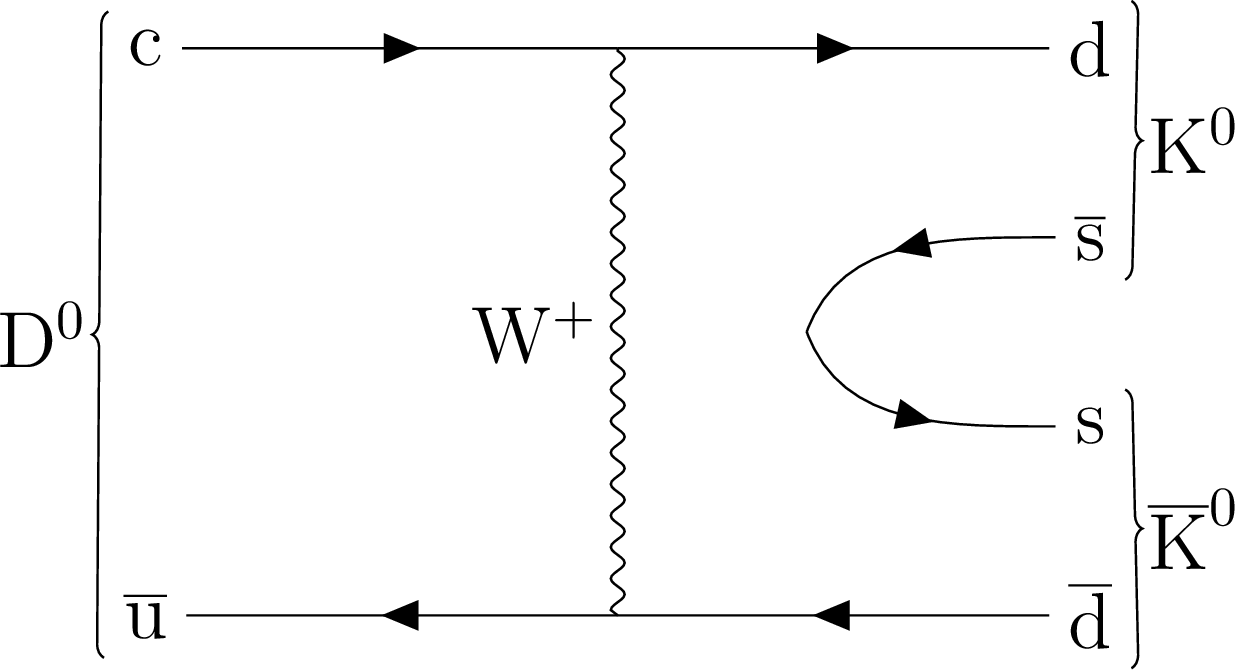
png pdf |
Figure 1-a:
The decay of neutral charm meson to two neutral kaons: exchange (left) and penguin annihilation (right) diagrams. |
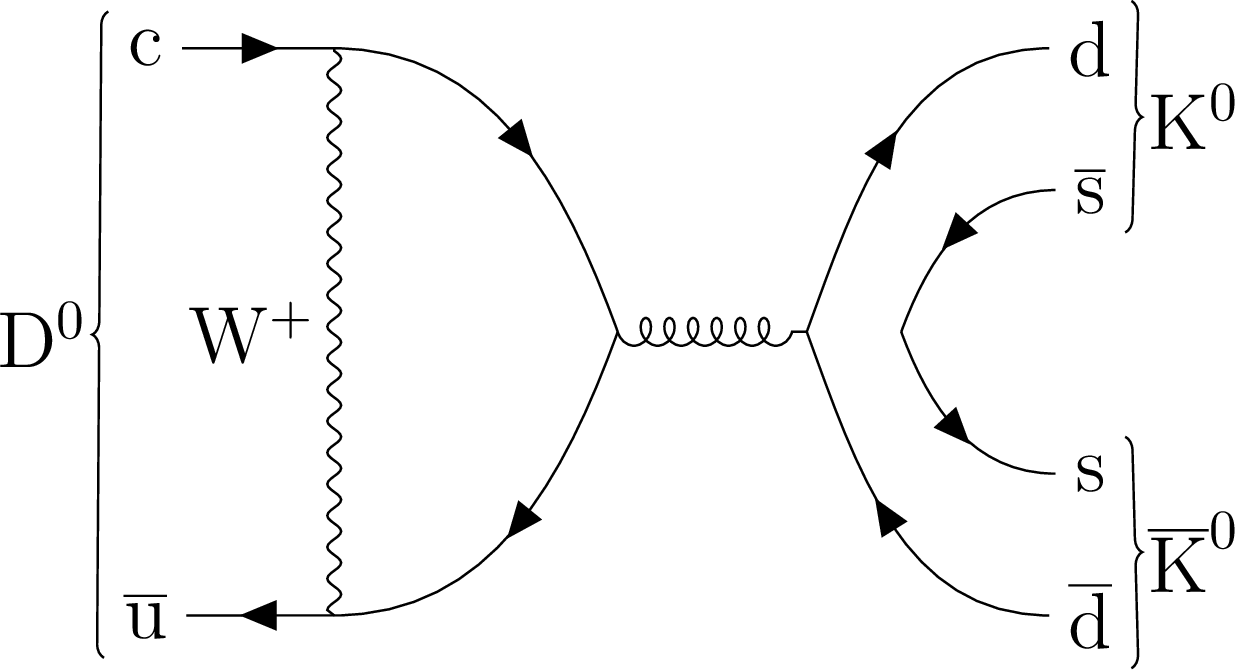
png pdf |
Figure 1-b:
The decay of neutral charm meson to two neutral kaons: exchange (left) and penguin annihilation (right) diagrams. |
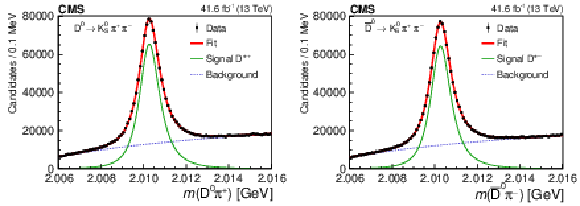
png pdf |
Figure 2:
The $ \mathrm{D^0}\pi^{+} $ (left) and $ \overline{\mathrm{D}}^{0}\pi^{-} $ (right) invariant mass distributions for the $ \mathrm{K^0_S}\pi^{+}\pi^{-} $ channel, with the result of the fit to both distributions. |
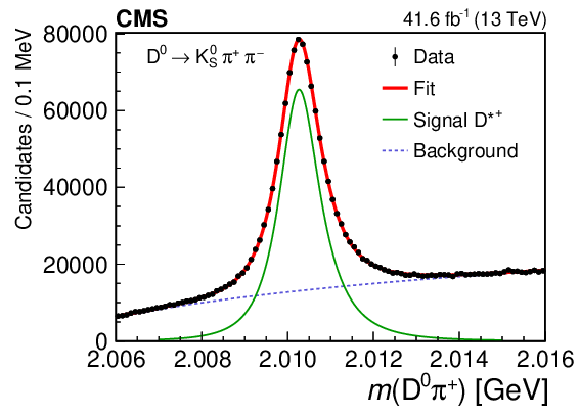
png pdf |
Figure 2-a:
The $ \mathrm{D^0}\pi^{+} $ (left) and $ \overline{\mathrm{D}}^{0}\pi^{-} $ (right) invariant mass distributions for the $ \mathrm{K^0_S}\pi^{+}\pi^{-} $ channel, with the result of the fit to both distributions. |
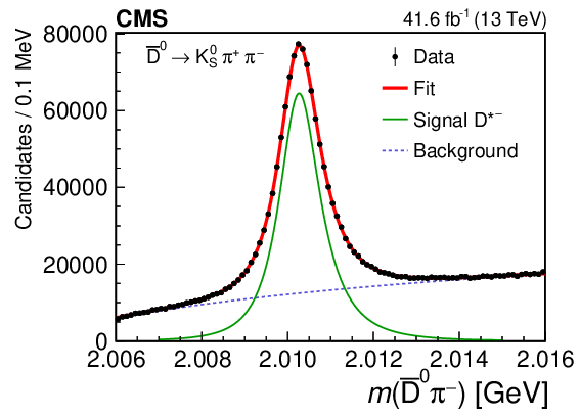
png pdf |
Figure 2-b:
The $ \mathrm{D^0}\pi^{+} $ (left) and $ \overline{\mathrm{D}}^{0}\pi^{-} $ (right) invariant mass distributions for the $ \mathrm{K^0_S}\pi^{+}\pi^{-} $ channel, with the result of the fit to both distributions. |
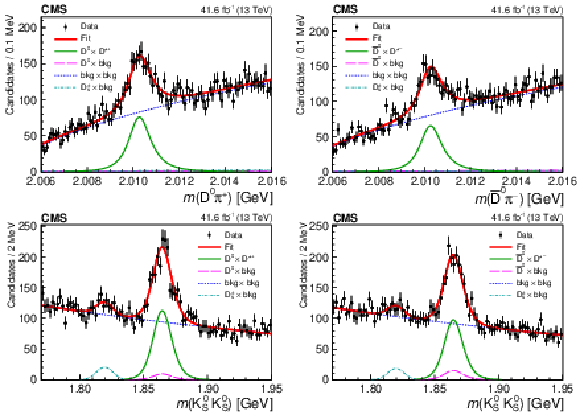
png pdf |
Figure 3:
The invariant mass distributions for $ \mathrm{D}^{*+} $ candidates (left) and $ \mathrm{D}^{*-} $ candidates (right), with the $ m(\mathrm{D}\pi^{\pm}) $ distributions in the upper row and the $ m(\mathrm{K^0_S}\mathrm{K^0_S}) $ distributions in the lower row. Projections of the simultaneous 2D fit are also shown. |
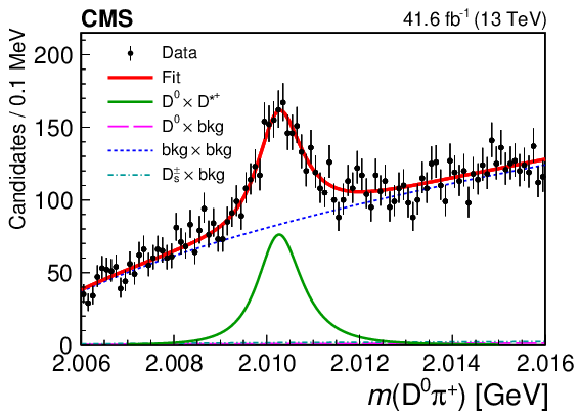
png pdf |
Figure 3-a:
The invariant mass distributions for $ \mathrm{D}^{*+} $ candidates (left) and $ \mathrm{D}^{*-} $ candidates (right), with the $ m(\mathrm{D}\pi^{\pm}) $ distributions in the upper row and the $ m(\mathrm{K^0_S}\mathrm{K^0_S}) $ distributions in the lower row. Projections of the simultaneous 2D fit are also shown. |
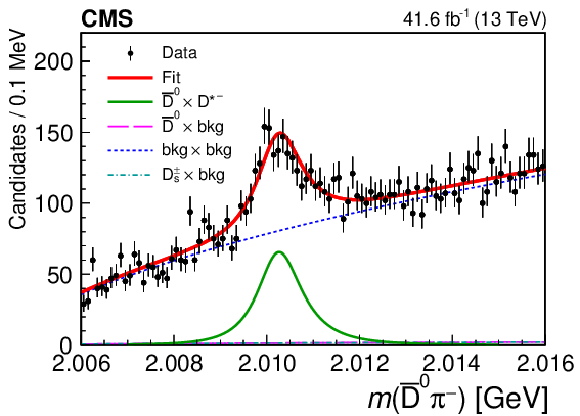
png pdf |
Figure 3-b:
The invariant mass distributions for $ \mathrm{D}^{*+} $ candidates (left) and $ \mathrm{D}^{*-} $ candidates (right), with the $ m(\mathrm{D}\pi^{\pm}) $ distributions in the upper row and the $ m(\mathrm{K^0_S}\mathrm{K^0_S}) $ distributions in the lower row. Projections of the simultaneous 2D fit are also shown. |
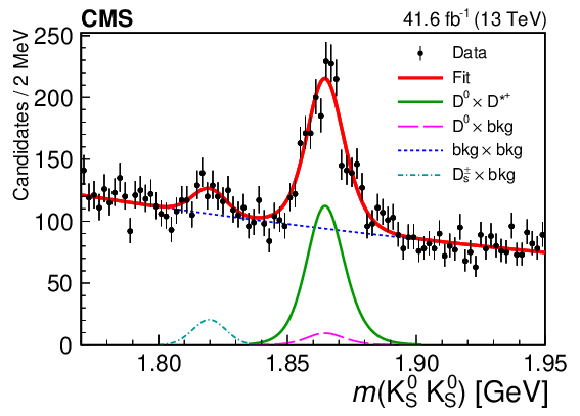
png pdf |
Figure 3-c:
The invariant mass distributions for $ \mathrm{D}^{*+} $ candidates (left) and $ \mathrm{D}^{*-} $ candidates (right), with the $ m(\mathrm{D}\pi^{\pm}) $ distributions in the upper row and the $ m(\mathrm{K^0_S}\mathrm{K^0_S}) $ distributions in the lower row. Projections of the simultaneous 2D fit are also shown. |
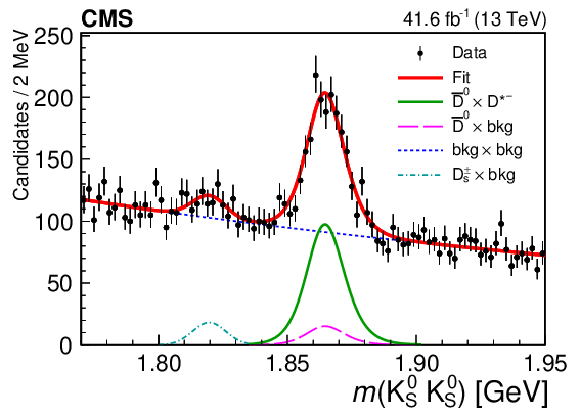
png pdf |
Figure 3-d:
The invariant mass distributions for $ \mathrm{D}^{*+} $ candidates (left) and $ \mathrm{D}^{*-} $ candidates (right), with the $ m(\mathrm{D}\pi^{\pm}) $ distributions in the upper row and the $ m(\mathrm{K^0_S}\mathrm{K^0_S}) $ distributions in the lower row. Projections of the simultaneous 2D fit are also shown. |
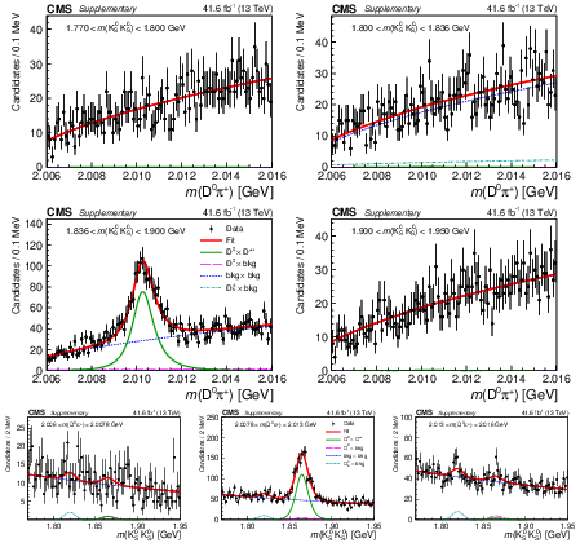
png pdf |
Figure 4:
Results of the 2D fit to the $ m(\mathrm{D}\pi^{\pm}) \times m(\mathrm{K^0_S}\mathrm{K^0_S}) $ for the signal channel, $ \mathrm{D}^{*+} $ candidates. Upper and middle rows show 1D projections of the 2D fit on $ m(\mathrm{D^0}\pi^{+}) $ in ranges of $ m(\mathrm{K^0_S}\mathrm{K^0_S}) $: left sideband (upper left), region of $ \mathrm{D}_{s}^{\pm}\to\mathrm{K^0_S}\mathrm{K^0_S}\pi^{\pm} $ contamination (upper right), signal region of $ \mathrm{K^0_S}\mathrm{K^0_S} $ (middle left), and right sideband (middle right). Lower row shows 1D projections of the 2D fit on $ m(\mathrm{K^0_S}\mathrm{K^0_S}) $ in ranges of $ m(\mathrm{D^0}\pi^{+}) $: left sideband (left), signal region of $ \mathrm{D^0}\pi^{+} $ (center), and right sideband (right). |
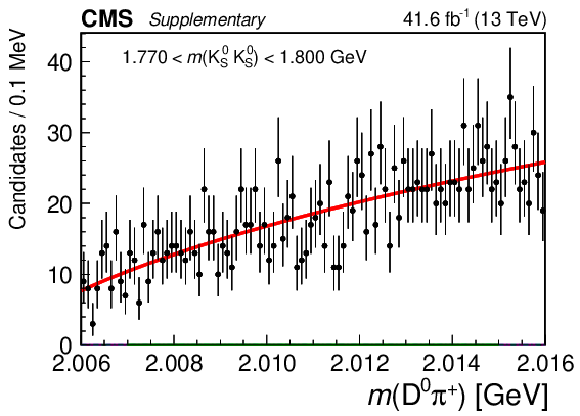
png pdf |
Figure 4-a:
Results of the 2D fit to the $ m(\mathrm{D}\pi^{\pm}) \times m(\mathrm{K^0_S}\mathrm{K^0_S}) $ for the signal channel, $ \mathrm{D}^{*+} $ candidates. Upper and middle rows show 1D projections of the 2D fit on $ m(\mathrm{D^0}\pi^{+}) $ in ranges of $ m(\mathrm{K^0_S}\mathrm{K^0_S}) $: left sideband (upper left), region of $ \mathrm{D}_{s}^{\pm}\to\mathrm{K^0_S}\mathrm{K^0_S}\pi^{\pm} $ contamination (upper right), signal region of $ \mathrm{K^0_S}\mathrm{K^0_S} $ (middle left), and right sideband (middle right). Lower row shows 1D projections of the 2D fit on $ m(\mathrm{K^0_S}\mathrm{K^0_S}) $ in ranges of $ m(\mathrm{D^0}\pi^{+}) $: left sideband (left), signal region of $ \mathrm{D^0}\pi^{+} $ (center), and right sideband (right). |
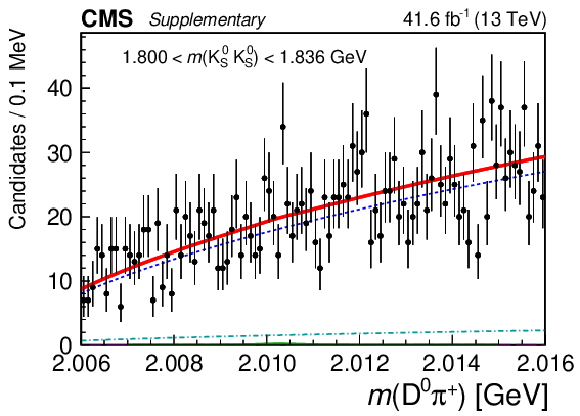
png pdf |
Figure 4-b:
Results of the 2D fit to the $ m(\mathrm{D}\pi^{\pm}) \times m(\mathrm{K^0_S}\mathrm{K^0_S}) $ for the signal channel, $ \mathrm{D}^{*+} $ candidates. Upper and middle rows show 1D projections of the 2D fit on $ m(\mathrm{D^0}\pi^{+}) $ in ranges of $ m(\mathrm{K^0_S}\mathrm{K^0_S}) $: left sideband (upper left), region of $ \mathrm{D}_{s}^{\pm}\to\mathrm{K^0_S}\mathrm{K^0_S}\pi^{\pm} $ contamination (upper right), signal region of $ \mathrm{K^0_S}\mathrm{K^0_S} $ (middle left), and right sideband (middle right). Lower row shows 1D projections of the 2D fit on $ m(\mathrm{K^0_S}\mathrm{K^0_S}) $ in ranges of $ m(\mathrm{D^0}\pi^{+}) $: left sideband (left), signal region of $ \mathrm{D^0}\pi^{+} $ (center), and right sideband (right). |
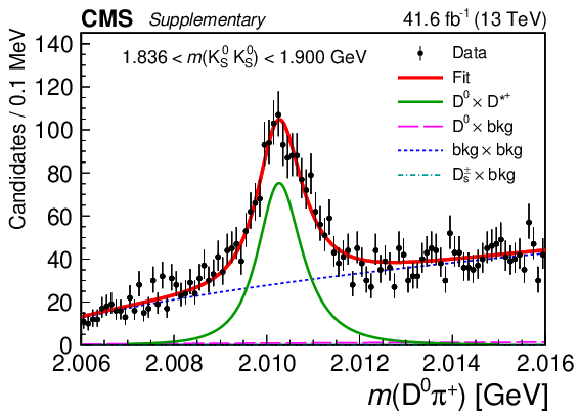
png pdf |
Figure 4-c:
Results of the 2D fit to the $ m(\mathrm{D}\pi^{\pm}) \times m(\mathrm{K^0_S}\mathrm{K^0_S}) $ for the signal channel, $ \mathrm{D}^{*+} $ candidates. Upper and middle rows show 1D projections of the 2D fit on $ m(\mathrm{D^0}\pi^{+}) $ in ranges of $ m(\mathrm{K^0_S}\mathrm{K^0_S}) $: left sideband (upper left), region of $ \mathrm{D}_{s}^{\pm}\to\mathrm{K^0_S}\mathrm{K^0_S}\pi^{\pm} $ contamination (upper right), signal region of $ \mathrm{K^0_S}\mathrm{K^0_S} $ (middle left), and right sideband (middle right). Lower row shows 1D projections of the 2D fit on $ m(\mathrm{K^0_S}\mathrm{K^0_S}) $ in ranges of $ m(\mathrm{D^0}\pi^{+}) $: left sideband (left), signal region of $ \mathrm{D^0}\pi^{+} $ (center), and right sideband (right). |
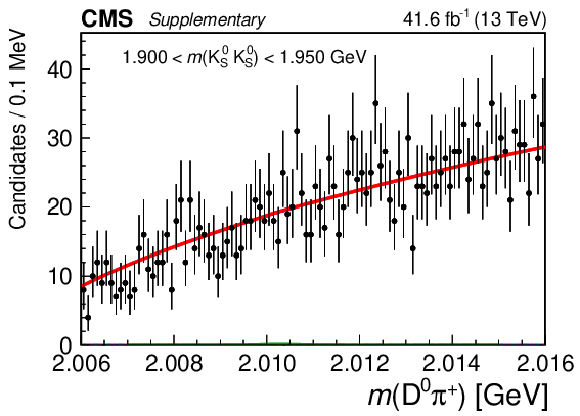
png pdf |
Figure 4-d:
Results of the 2D fit to the $ m(\mathrm{D}\pi^{\pm}) \times m(\mathrm{K^0_S}\mathrm{K^0_S}) $ for the signal channel, $ \mathrm{D}^{*+} $ candidates. Upper and middle rows show 1D projections of the 2D fit on $ m(\mathrm{D^0}\pi^{+}) $ in ranges of $ m(\mathrm{K^0_S}\mathrm{K^0_S}) $: left sideband (upper left), region of $ \mathrm{D}_{s}^{\pm}\to\mathrm{K^0_S}\mathrm{K^0_S}\pi^{\pm} $ contamination (upper right), signal region of $ \mathrm{K^0_S}\mathrm{K^0_S} $ (middle left), and right sideband (middle right). Lower row shows 1D projections of the 2D fit on $ m(\mathrm{K^0_S}\mathrm{K^0_S}) $ in ranges of $ m(\mathrm{D^0}\pi^{+}) $: left sideband (left), signal region of $ \mathrm{D^0}\pi^{+} $ (center), and right sideband (right). |
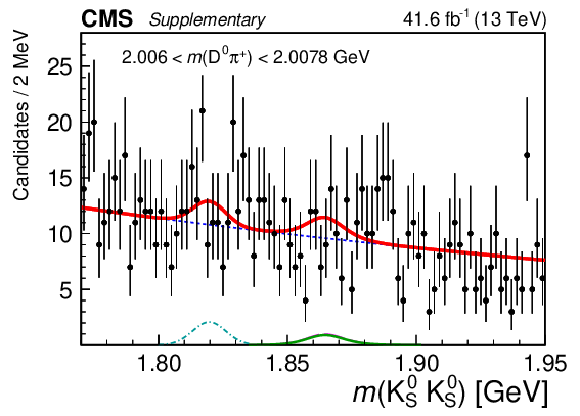
png pdf |
Figure 4-e:
Results of the 2D fit to the $ m(\mathrm{D}\pi^{\pm}) \times m(\mathrm{K^0_S}\mathrm{K^0_S}) $ for the signal channel, $ \mathrm{D}^{*+} $ candidates. Upper and middle rows show 1D projections of the 2D fit on $ m(\mathrm{D^0}\pi^{+}) $ in ranges of $ m(\mathrm{K^0_S}\mathrm{K^0_S}) $: left sideband (upper left), region of $ \mathrm{D}_{s}^{\pm}\to\mathrm{K^0_S}\mathrm{K^0_S}\pi^{\pm} $ contamination (upper right), signal region of $ \mathrm{K^0_S}\mathrm{K^0_S} $ (middle left), and right sideband (middle right). Lower row shows 1D projections of the 2D fit on $ m(\mathrm{K^0_S}\mathrm{K^0_S}) $ in ranges of $ m(\mathrm{D^0}\pi^{+}) $: left sideband (left), signal region of $ \mathrm{D^0}\pi^{+} $ (center), and right sideband (right). |
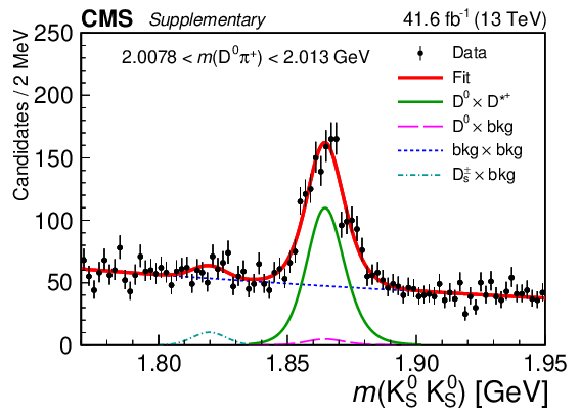
png pdf |
Figure 4-f:
Results of the 2D fit to the $ m(\mathrm{D}\pi^{\pm}) \times m(\mathrm{K^0_S}\mathrm{K^0_S}) $ for the signal channel, $ \mathrm{D}^{*+} $ candidates. Upper and middle rows show 1D projections of the 2D fit on $ m(\mathrm{D^0}\pi^{+}) $ in ranges of $ m(\mathrm{K^0_S}\mathrm{K^0_S}) $: left sideband (upper left), region of $ \mathrm{D}_{s}^{\pm}\to\mathrm{K^0_S}\mathrm{K^0_S}\pi^{\pm} $ contamination (upper right), signal region of $ \mathrm{K^0_S}\mathrm{K^0_S} $ (middle left), and right sideband (middle right). Lower row shows 1D projections of the 2D fit on $ m(\mathrm{K^0_S}\mathrm{K^0_S}) $ in ranges of $ m(\mathrm{D^0}\pi^{+}) $: left sideband (left), signal region of $ \mathrm{D^0}\pi^{+} $ (center), and right sideband (right). |
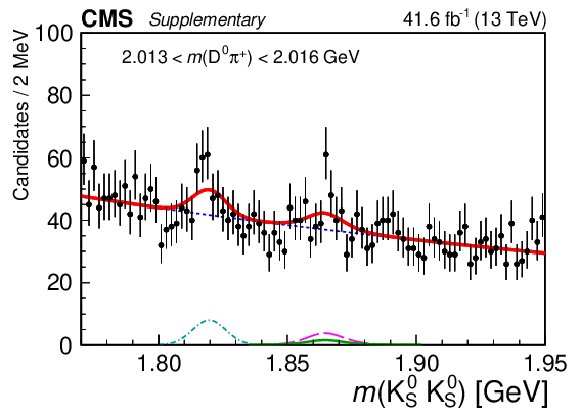
png pdf |
Figure 4-g:
Results of the 2D fit to the $ m(\mathrm{D}\pi^{\pm}) \times m(\mathrm{K^0_S}\mathrm{K^0_S}) $ for the signal channel, $ \mathrm{D}^{*+} $ candidates. Upper and middle rows show 1D projections of the 2D fit on $ m(\mathrm{D^0}\pi^{+}) $ in ranges of $ m(\mathrm{K^0_S}\mathrm{K^0_S}) $: left sideband (upper left), region of $ \mathrm{D}_{s}^{\pm}\to\mathrm{K^0_S}\mathrm{K^0_S}\pi^{\pm} $ contamination (upper right), signal region of $ \mathrm{K^0_S}\mathrm{K^0_S} $ (middle left), and right sideband (middle right). Lower row shows 1D projections of the 2D fit on $ m(\mathrm{K^0_S}\mathrm{K^0_S}) $ in ranges of $ m(\mathrm{D^0}\pi^{+}) $: left sideband (left), signal region of $ \mathrm{D^0}\pi^{+} $ (center), and right sideband (right). |
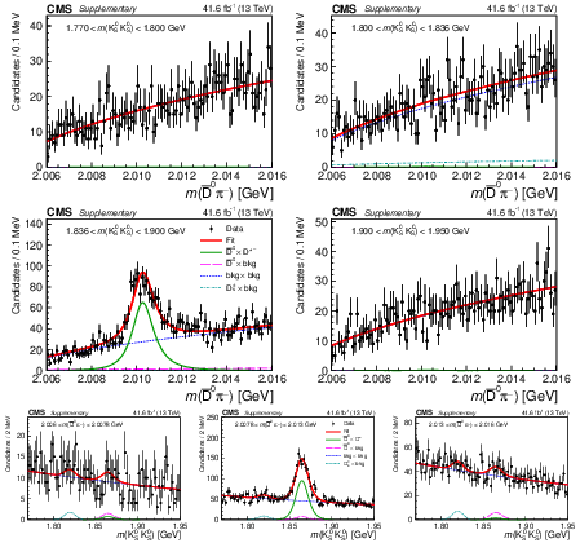
png pdf |
Figure 5:
Results of the 2D fit to the $ m(\mathrm{D}\pi^{\pm}) \times m(\mathrm{K^0_S}\mathrm{K^0_S}) $ for the signal channel, $ \mathrm{D}^{*-} $ candidates. Upper and middle rows show 1D projections of the 2D fit on $ m(\overline{\mathrm{D}}^{0}\pi^{-}) $ in ranges of $ m(\mathrm{K^0_S}\mathrm{K^0_S}) $: left sideband (upper left), region of $ \mathrm{D}_{s}^{\pm}\to\mathrm{K^0_S}\mathrm{K^0_S}\pi^{\pm} $ contamination (upper right), signal region of $ \mathrm{K^0_S}\mathrm{K^0_S} $ (middle left), and right sideband (middle right). Lower row shows 1D projections of the 2D fit on $ m(\mathrm{K^0_S}\mathrm{K^0_S}) $ in ranges of $ m(\overline{\mathrm{D}}^{0}\pi^{-}) $: left sideband (left), signal region of $ \overline{\mathrm{D}}^{0}\pi^{-} $ (center), and right sideband (right). |
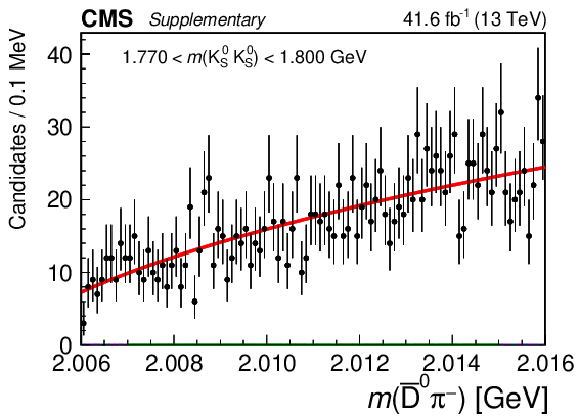
png pdf |
Figure 5-a:
Results of the 2D fit to the $ m(\mathrm{D}\pi^{\pm}) \times m(\mathrm{K^0_S}\mathrm{K^0_S}) $ for the signal channel, $ \mathrm{D}^{*-} $ candidates. Upper and middle rows show 1D projections of the 2D fit on $ m(\overline{\mathrm{D}}^{0}\pi^{-}) $ in ranges of $ m(\mathrm{K^0_S}\mathrm{K^0_S}) $: left sideband (upper left), region of $ \mathrm{D}_{s}^{\pm}\to\mathrm{K^0_S}\mathrm{K^0_S}\pi^{\pm} $ contamination (upper right), signal region of $ \mathrm{K^0_S}\mathrm{K^0_S} $ (middle left), and right sideband (middle right). Lower row shows 1D projections of the 2D fit on $ m(\mathrm{K^0_S}\mathrm{K^0_S}) $ in ranges of $ m(\overline{\mathrm{D}}^{0}\pi^{-}) $: left sideband (left), signal region of $ \overline{\mathrm{D}}^{0}\pi^{-} $ (center), and right sideband (right). |
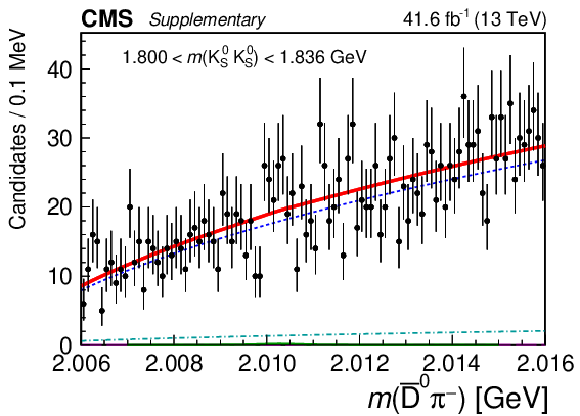
png pdf |
Figure 5-b:
Results of the 2D fit to the $ m(\mathrm{D}\pi^{\pm}) \times m(\mathrm{K^0_S}\mathrm{K^0_S}) $ for the signal channel, $ \mathrm{D}^{*-} $ candidates. Upper and middle rows show 1D projections of the 2D fit on $ m(\overline{\mathrm{D}}^{0}\pi^{-}) $ in ranges of $ m(\mathrm{K^0_S}\mathrm{K^0_S}) $: left sideband (upper left), region of $ \mathrm{D}_{s}^{\pm}\to\mathrm{K^0_S}\mathrm{K^0_S}\pi^{\pm} $ contamination (upper right), signal region of $ \mathrm{K^0_S}\mathrm{K^0_S} $ (middle left), and right sideband (middle right). Lower row shows 1D projections of the 2D fit on $ m(\mathrm{K^0_S}\mathrm{K^0_S}) $ in ranges of $ m(\overline{\mathrm{D}}^{0}\pi^{-}) $: left sideband (left), signal region of $ \overline{\mathrm{D}}^{0}\pi^{-} $ (center), and right sideband (right). |
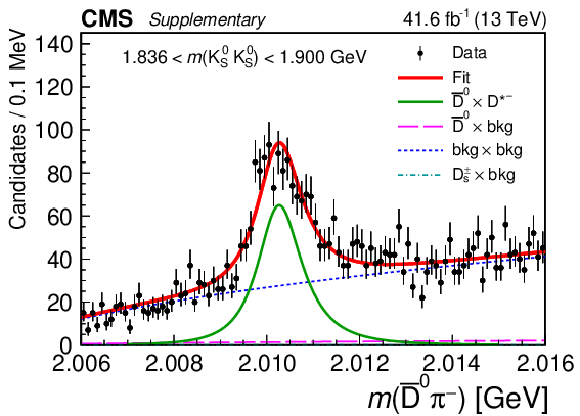
png pdf |
Figure 5-c:
Results of the 2D fit to the $ m(\mathrm{D}\pi^{\pm}) \times m(\mathrm{K^0_S}\mathrm{K^0_S}) $ for the signal channel, $ \mathrm{D}^{*-} $ candidates. Upper and middle rows show 1D projections of the 2D fit on $ m(\overline{\mathrm{D}}^{0}\pi^{-}) $ in ranges of $ m(\mathrm{K^0_S}\mathrm{K^0_S}) $: left sideband (upper left), region of $ \mathrm{D}_{s}^{\pm}\to\mathrm{K^0_S}\mathrm{K^0_S}\pi^{\pm} $ contamination (upper right), signal region of $ \mathrm{K^0_S}\mathrm{K^0_S} $ (middle left), and right sideband (middle right). Lower row shows 1D projections of the 2D fit on $ m(\mathrm{K^0_S}\mathrm{K^0_S}) $ in ranges of $ m(\overline{\mathrm{D}}^{0}\pi^{-}) $: left sideband (left), signal region of $ \overline{\mathrm{D}}^{0}\pi^{-} $ (center), and right sideband (right). |
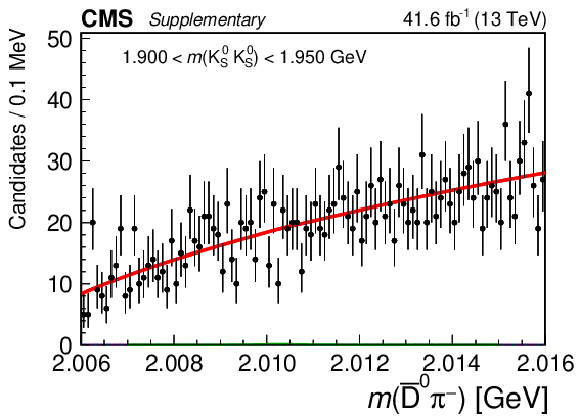
png pdf |
Figure 5-d:
Results of the 2D fit to the $ m(\mathrm{D}\pi^{\pm}) \times m(\mathrm{K^0_S}\mathrm{K^0_S}) $ for the signal channel, $ \mathrm{D}^{*-} $ candidates. Upper and middle rows show 1D projections of the 2D fit on $ m(\overline{\mathrm{D}}^{0}\pi^{-}) $ in ranges of $ m(\mathrm{K^0_S}\mathrm{K^0_S}) $: left sideband (upper left), region of $ \mathrm{D}_{s}^{\pm}\to\mathrm{K^0_S}\mathrm{K^0_S}\pi^{\pm} $ contamination (upper right), signal region of $ \mathrm{K^0_S}\mathrm{K^0_S} $ (middle left), and right sideband (middle right). Lower row shows 1D projections of the 2D fit on $ m(\mathrm{K^0_S}\mathrm{K^0_S}) $ in ranges of $ m(\overline{\mathrm{D}}^{0}\pi^{-}) $: left sideband (left), signal region of $ \overline{\mathrm{D}}^{0}\pi^{-} $ (center), and right sideband (right). |
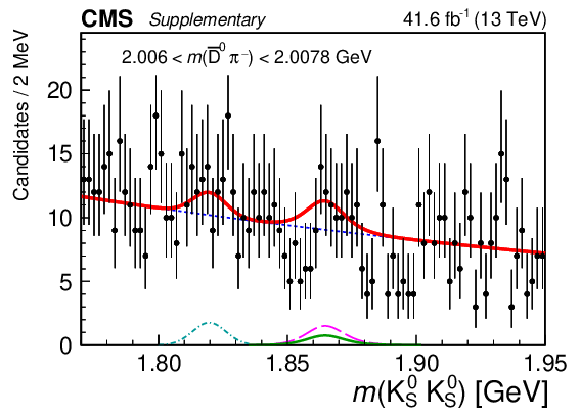
png pdf |
Figure 5-e:
Results of the 2D fit to the $ m(\mathrm{D}\pi^{\pm}) \times m(\mathrm{K^0_S}\mathrm{K^0_S}) $ for the signal channel, $ \mathrm{D}^{*-} $ candidates. Upper and middle rows show 1D projections of the 2D fit on $ m(\overline{\mathrm{D}}^{0}\pi^{-}) $ in ranges of $ m(\mathrm{K^0_S}\mathrm{K^0_S}) $: left sideband (upper left), region of $ \mathrm{D}_{s}^{\pm}\to\mathrm{K^0_S}\mathrm{K^0_S}\pi^{\pm} $ contamination (upper right), signal region of $ \mathrm{K^0_S}\mathrm{K^0_S} $ (middle left), and right sideband (middle right). Lower row shows 1D projections of the 2D fit on $ m(\mathrm{K^0_S}\mathrm{K^0_S}) $ in ranges of $ m(\overline{\mathrm{D}}^{0}\pi^{-}) $: left sideband (left), signal region of $ \overline{\mathrm{D}}^{0}\pi^{-} $ (center), and right sideband (right). |
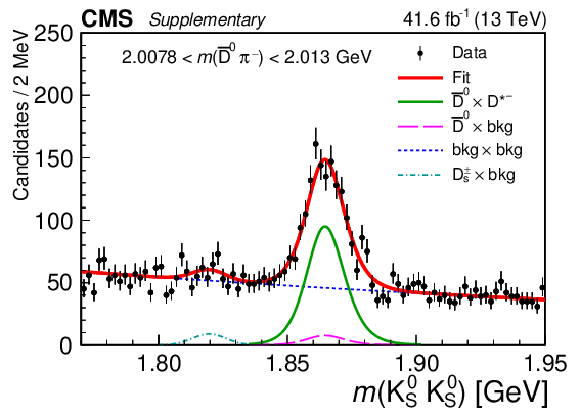
png pdf |
Figure 5-f:
Results of the 2D fit to the $ m(\mathrm{D}\pi^{\pm}) \times m(\mathrm{K^0_S}\mathrm{K^0_S}) $ for the signal channel, $ \mathrm{D}^{*-} $ candidates. Upper and middle rows show 1D projections of the 2D fit on $ m(\overline{\mathrm{D}}^{0}\pi^{-}) $ in ranges of $ m(\mathrm{K^0_S}\mathrm{K^0_S}) $: left sideband (upper left), region of $ \mathrm{D}_{s}^{\pm}\to\mathrm{K^0_S}\mathrm{K^0_S}\pi^{\pm} $ contamination (upper right), signal region of $ \mathrm{K^0_S}\mathrm{K^0_S} $ (middle left), and right sideband (middle right). Lower row shows 1D projections of the 2D fit on $ m(\mathrm{K^0_S}\mathrm{K^0_S}) $ in ranges of $ m(\overline{\mathrm{D}}^{0}\pi^{-}) $: left sideband (left), signal region of $ \overline{\mathrm{D}}^{0}\pi^{-} $ (center), and right sideband (right). |
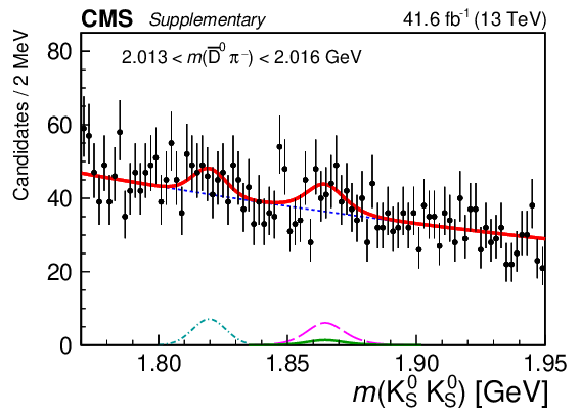
png pdf |
Figure 5-g:
Results of the 2D fit to the $ m(\mathrm{D}\pi^{\pm}) \times m(\mathrm{K^0_S}\mathrm{K^0_S}) $ for the signal channel, $ \mathrm{D}^{*-} $ candidates. Upper and middle rows show 1D projections of the 2D fit on $ m(\overline{\mathrm{D}}^{0}\pi^{-}) $ in ranges of $ m(\mathrm{K^0_S}\mathrm{K^0_S}) $: left sideband (upper left), region of $ \mathrm{D}_{s}^{\pm}\to\mathrm{K^0_S}\mathrm{K^0_S}\pi^{\pm} $ contamination (upper right), signal region of $ \mathrm{K^0_S}\mathrm{K^0_S} $ (middle left), and right sideband (middle right). Lower row shows 1D projections of the 2D fit on $ m(\mathrm{K^0_S}\mathrm{K^0_S}) $ in ranges of $ m(\overline{\mathrm{D}}^{0}\pi^{-}) $: left sideband (left), signal region of $ \overline{\mathrm{D}}^{0}\pi^{-} $ (center), and right sideband (right). |
| Tables | |

png pdf |
Table 1:
Optimized selection criteria in the signal channel $ \mathrm{K^0_S}\mathrm{K^0_S} $. The requirements on the $ \mathrm{K^0_S} $ candidates in the third and fourth lines are given first for the $ \mathrm{K^0_S} $ with larger $ p_{\mathrm{T}} $, then for the $ \mathrm{K^0_S} $ with lower $ p_{\mathrm{T}} $. |

png pdf |
Table 2:
Results of the fit to the selected $ \mathrm{D}^{*+}\to\mathrm{D^0}\pi^{+} $ and $ \mathrm{D}^{*-}\to\overline{\mathrm{D}}^{0}\pi^{-} $ candidates, where $ \mathrm{D^0}\,(\overline{\mathrm{D}}^{0}) \to\mathrm{K^0_S}\pi^{+}\pi^{-} $. The $ {\mathrm{D}^{\ast}(2010)^{\pm}} $ signal yields $ N $ given in the second column are used in the evaluation of $ A_{CP}^{\text{raw}} $. The uncertainties are statistical only. |

png pdf |
Table 3:
Results of the 2D fit to the selected $ \mathrm{D}^{*+}\to\mathrm{D^0}\pi^{+} $ and $ \mathrm{D}^{*-}\to\overline{\mathrm{D}}^{0}\pi^{-} $ candidates, where $ \mathrm{D^0}\,(\overline{\mathrm{D}}^{0}) \to\mathrm{K^0_S}\mathrm{K^0_S} $. The $ {\mathrm{D}^{\ast}(2010)^{\pm}} $ signal yields $ N $ given in the second column are used in the evaluation of $ A_{CP}^{\text{raw}} $. The $ \chi^2 $ corresponds to the fit projection with 100 bins in the $ x = m(\mathrm{D}\pi^{\pm}) $ axis and 90 bins in the $ y = m(\mathrm{K^0_S}\mathrm{K^0_S}) $ axis, as shown in Fig 3. The uncertainties are statistical only. |
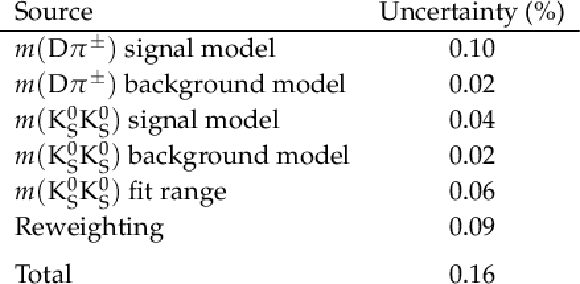
png pdf |
Table 4:
Absolute systematic uncertainties in the measurement of $ \Delta A_{CP} $. |
| Summary |
| A measurement of CP violation in $ \mathrm{D^0} $ decays is reported, using proton-proton collision data collected at $ \sqrt{s} = $ 13 TeV with a novel high-rate data stream (B parking). These data correspond to an integrated luminosity of 41.6 fb$ ^{-1} $ and include about 10 billion events containing beauty hadron decays. The difference in the CP asymmetries between $ \mathrm{D^0}\to\mathrm{K^0_S}\mathrm{K^0_S} $ and $ \mathrm{D^0}\to\mathrm{K^0_S}\pi^{+}\pi^{-} $ is measured to be: $ \Delta A_{CP} \equiv A_{CP}(\mathrm{K^0_S}\mathrm{K^0_S})-A_{CP}(\mathrm{K^0_S}\pi^{+}\pi^{-}) = $ (6.3 $\pm$ 3.0 (stat) $\pm$ 0.2 (syst) )%. Using the world-average value of $ A_{CP}(\mathrm{K^0_S}\pi^{+}\pi^{-}) = (- $ 0.1 $ \pm $ 0.8 $)% $ [18,35,4], we report the measurement, $ A_{CP}(\mathrm{K^0_S}\mathrm{K^0_S}) = $(6.2 $\pm$ 3.0 $\pm$ 0.2 $\pm$ 0.8)%, where the three uncertainties represent the statistical uncertainty, the systematic uncertainty, and the uncertainty in the measurement of the CP asymmetry in the $ \mathrm{D^0}\to\mathrm{K^0_S}\pi^{+}\pi^{-} $ decay. The measured value is consistent with no CP violation within 2.0 standard deviations. Likewise, it is consistent with the LHCb [16] and the Belle measurements [17] at the level of 2.7 and 1.8 standard deviations, respectively. Tabulated results are provided in the HEPData record for this analysis [36]. This is the first CMS search for CP violation in the charm sector, paving the way for future measurements with more data, using new techniques, and in other channels. |
| References | ||||
| 1 | A. D. Sakharov | Violation of CP invariance, C asymmetry, and baryon asymmetry of the universe | Pisma Zh. Eksp. Teor. Fiz. 5 (1967) 32 | |
| 2 | N. Cabibbo et al. | Unitary symmetry and leptonic decays | PRL 10 (1963) 531 | |
| 3 | M. Kobayashi and T. Maskawa | CP-violation in the renormalizable theory of weak interaction | Prog. Theor. Phys. 49 (1973) 652 | |
| 4 | Particle Data Group | Review of particle physics | PTEP 2022 (2022) 083C01 | |
| 5 | A. G. Cohen, D. B. Kaplan, and A. E. Nelson | Progress in electroweak baryogenesis | Ann. Rev. Nucl. Part. Sci. 43 (1993) 27 | hep-ph/9302210 |
| 6 | A. Riotto and M. Trodden | Recent progress in baryogenesis | Ann. Rev. Nucl. Part. Sci. 49 (1999) 35 | hep-ph/9901362 |
| 7 | W.-S. Hou | Source of CP violation for the baryon asymmetry of the Universe | Chin. J. Phys. 47 (2009) 134 | 0803.1234 |
| 8 | S. L. Glashow, J. Iliopoulos, and L. Maiani | Weak interactions with lepton-hadron symmetry | PRD 2 (1970) 1285 | |
| 9 | LHCb Collaboration | Observation of CP violation in charm decays | PRL 122 (2019) 211803 | 1903.08726 |
| 10 | A. Lenz and G. Wilkinson | Mixing and CP violation in the charm system | Ann. Rev. Nucl. Part. Sci. 71 (2021) 59 | 2011.04443 |
| 11 | U. Nierste and S. Schacht | $ CP $ violation in $ {D}^{0}\to{K}_{S}{K}_{S} $ | PRD 92 (2015) 054036 | 1508.00074 |
| 12 | H.-n. Li, C.-D. Lu, and F.-S. Yu | Branching ratios and direct $ CP $ asymmetries in $ D\to \pi^{+}\pi^{-} $ decays | PRD 86 (2012) 036012 | 1203.3120 |
| 13 | H.-Y. Cheng and C.-W. Chiang | Revisiting $ CP $ violation in $ D\to \pi^{+}\pi^{-} $ and $ VP $ decays | PRD 100 (2019) 093002 | 1909.03063 |
| 14 | F. Buccella, A. Paul, and P. Santorelli | $ SU(3{)}_{F} $ breaking through final state interactions and $ CP $ asymmetries in $ D\to \pi^{+}\pi^{-} $ decays | PRD 99 (2019) 113001 | 1902.05564 |
| 15 | J. Brod, A. L. Kagan, and J. Zupan | Size of direct $ CP $ violation in singly Cabibbo-suppressed $ D $ decays | PRD 86 (2012) 014023 | 1111.5000 |
| 16 | LHCb Collaboration | Measurement of $ CP $ asymmetry in $ D^0 \to K^0_S K^0_S $ decays | PRD 104 (2021) L031102 | 2105.01565 |
| 17 | Belle Collaboration | Search for $ CP $ violation and measurement of the branching fraction in the decay $ D^{0} \to K^0_S K^0_S $ | PRL 119 (2017) 171801 | 1705.05966 |
| 18 | CDF Collaboration | Measurement of CP-violation asymmetries in $ D^{0} \to K^{0}_{S} \pi^+ \pi^- $ | PRD 86 (2012) 032007 | 1207.0825 |
| 19 | CMS Collaboration | Test of lepton flavor universality in $ {\mathrm{B}^{\pm}}\to\mathrm{K^{\pm}}\mu^{+}\mu^{-} $ and $ {\mathrm{B}^{\pm}}\to\mathrm{K^{\pm}}\mathrm{e}^+\mathrm{e}^- $ decays in proton-proton collisions at $ \sqrt{s} $ = 13 TeV | Submitted to Phys. Rep., 2024 | CMS-BPH-22-005 2401.07090 |
| 20 | CMS Collaboration | Enriching the physics program of the CMS experiment via data scouting and data parking | Submitted to Phys. Rep., 2024 | CMS-EXO-23-007 2403.16134 |
| 21 | CMS Tracker Group Collaboration | The CMS Phase-1 pixel detector upgrade | JINST 16 (2021) P02027 | 2012.14304 |
| 22 | CMS Collaboration | Track impact parameter resolution for the full pseudo rapidity coverage in the 2017 dataset with the CMS Phase-1 pixel detector | CMS Detector Performance Note CMS-DP-2020-049, 2020 CDS |
|
| 23 | CMS Collaboration | Performance of the CMS Level-1 trigger in proton-proton collisions at $ \sqrt{s} = $ 13 TeV | JINST 15 (2020) P10017 | CMS-TRG-17-001 2006.10165 |
| 24 | CMS Collaboration | The CMS trigger system | JINST 12 (2017) P01020 | CMS-TRG-12-001 1609.02366 |
| 25 | CMS Collaboration | The CMS experiment at the CERN LHC | JINST 3 (2008) S08004 | |
| 26 | T. Sjöstrand et al. | An introduction to PYTHIA 8.2 | Comput. Phys. Commun. 191 (2015) 159 | 1410.3012 |
| 27 | D. J. Lange | The EvtGen particle decay simulation package | NIM A 462 (2001) 152 | |
| 28 | CMS Collaboration | Extraction and validation of a new set of CMS PYTHIA8 tunes from underlying-event measurements | EPJC 80 (2020) 4 | CMS-GEN-17-001 1903.12179 |
| 29 | E. Barberio and Z. Was | PHOTOS --- a universal Monte Carlo for QED radiative corrections: version 2.0 | Comput. Phys. Commun. 79 (1994) 291 | |
| 30 | GEANT4 Collaboration | GEANT 4 --- a simulation toolkit | NIM A 506 (2003) 250 | |
| 31 | CMS Collaboration | CMS tracking performance results from early LHC operation | EPJC 70 (2010) 1165 | CMS-TRK-10-001 1007.1988 |
| 32 | CMS Collaboration | Description and performance of track and primary-vertex reconstruction with the CMS tracker | JINST 9 (2014) P10009 | CMS-TRK-11-001 1405.6569 |
| 33 | N. L. Johnson | Systems of frequency curves generated by methods of translation | Biometrika 36 (1949) 149 | |
| 34 | M. J. Oreglia | A study of the reactions $ \psi^\prime \to \gamma \gamma \psi $ | PhD thesis, Stanford University, SLAC Report SLAC-R-236, 1980 link |
|
| 35 | CLEO Collaboration | Search for CP violation in $ \mathrm{D^0}\to\mathrm{K^0_S}\pi^{+}\pi^{-} $ | PRD 70 (2004) 091101 | hep-ex/0311033 |
| 36 | CMS Collaboration | HEPData record for this analysis | link | |

|
Compact Muon Solenoid LHC, CERN |

|

|

|

|

|

|